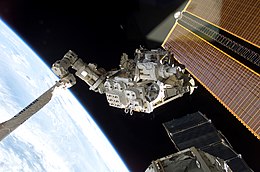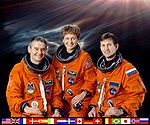STS-111
 Canadarm2 grapples the Mobile Base System, prior to its installation on the ISS' Mobile Servicing System | |
| Names | Space Transportation System-111 |
|---|---|
| Mission type | ISS logistics Crew rotation |
| Operator | NASA |
| COSPAR ID | 2002-028A |
| SATCAT no. | 27440 |
| Mission duration | 13 days, 20 hours, 35 minutes, 56 seconds |
| Distance travelled | 9,300,000 kilometres (5,800,000 mi) |
| Spacecraft properties | |
| Spacecraft | Space Shuttle Endeavour |
| Launch mass | 116,523 kilograms (256,889 lb) |
| Landing mass | 99,385 kilograms (219,106 lb) |
| Payload mass | 12,058 kilograms (26,583 lb) |
| Crew | |
| Crew size | 7 |
| Members |
|
| Start of mission | |
| Launch date | 5 June 2002 21:22:49 UTC |
| Launch site | Kennedy LC-39A |
| End of mission | |
| Landing date | 19 June 2002 17:58:45 UTC |
| Landing site | Edwards Runway 22 |
| Orbital parameters | |
| Reference system | Geocentric |
| Regime | Low Earth |
| Perigee altitude | 349 kilometres (217 mi) |
| Apogee altitude | 387 kilometres (240 mi) |
| Inclination | 51.6 degrees |
| Period | 91.9 minutes |
| Docking with PMA-2 (Destiny forward) | |
| Docking date | 7 June 2002 16:25 UTC |
| Undocking date | 15 June 2002 14:32 UTC |
| Time docked | 7 days, 22 hours, 7 minutes |

Franklin R. Chang-Diaz → | |
STS-111 was a space shuttle mission to the International Space Station (ISS) flown by Space Shuttle Endeavour. STS-111 resupplied the station and replaced the Expedition 4 crew with the Expedition 5 crew. It was launched on 5 June 2002, from Kennedy Space Center, Florida.
Crew


| Position | Launching Astronaut | Landing Astronaut |
|---|---|---|
| Commander | Kenneth D. Cockrell Fifth and last spaceflight | |
| Pilot | First spaceflight | |
| Mission Specialist 1 | Only spaceflight | |
| Mission Specialist 2 | Seventh and last spaceflight | |
| Mission Specialist 3 | RKA Expedition 5 Second and last spaceflight ISS Commander/Soyuz Commander |
RKA Expedition 4 Second and last spaceflight ISS Commander/Soyuz Commander |
| Mission Specialist 4 | Peggy A. Whitson Expedition 5 First spaceflight ISS Flight Engineer |
Expedition 4 Fourth and last spaceflight ISS Flight Engineer |
| Mission Specialist 5 | RKA Expedition 5 Only spaceflight ISS Flight Engineer |
Expedition 4 Fourth and last spaceflight ISS Flight Engineer |
Mission highlights


STS-111, in addition to providing supplies, rotated the crews aboard the International Space Station, exchanging the three Expedition 4 members (1 Russian, 2 American) for the three Expedition 5 members (2 Russian, 1 American).
The Multi-Purpose Logistics Module (MPLM) carried experiment racks and three stowage and resupply racks to the station. The mission also installed a component of the Canadarm2 called the Mobile Base System (MBS) to the Mobile Transporter (MT) (which was installed during STS-110); This was the second component of the Canadian Mobile Servicing System, or MSS. This gave the mechanical arm the capability to "inchworm" from the U.S. Lab fixture to the MBS and travel along the Truss to work sites.
STS-111 was the last flight of a CNES astronaut, the French agency having disbanded its astronaut group and transferred them to the ESA.
Spacewalks


| Mission | Spacewalkers | Start – UTC | End – UTC | Duration | Mission | |
|---|---|---|---|---|---|---|
| 39. | STS-111 EVA 1 |
Franklin R. Chang-Diaz
Philippe Perrin |
9 June 2002 15:27 |
9 June 2002 22:41 |
7 h, 14 min | Attached Power and Data Grapple Fixture to P6 Truss
|
| 40. | STS-111 EVA 2 |
Franklin R. Chang-Diaz
Philippe Perrin |
11 June 2002 15:20 |
11 June 2002 20:20[1][2] |
5 h, 00 min | Attached Mobile Base System to Mobile Transporter |
| 41. | STS-111 EVA 3 |
Franklin R. Chang-Diaz
Philippe Perrin |
13 June 2002 15:16 |
13 June 2002 22:33 |
7 h, 17 min | Replace Canadarm2 wrist joint
|
| Attempt | Planned | Result | Turnaround | Reason | Decision point | Weather go (%) | Notes |
|---|---|---|---|---|---|---|---|
| 1 | 30 May 2002, 7:44:26 pm | scrubbed | — | weather | 40% | thunderstorms and electrical activity | |
| 2 | 31 May 2002, 7:21:52 pm | scrubbed | 0 days, 23 hours, 37 minutes | weather | 31 May 2002, 9:45 am | 80% | scrubbed before tanking had begun, concerns of continued bad weather including hail |
| 3 | 5 Jun 2002, 5:22:48 am | success | 4 days, 10 hours, 1 minute | initial plans for Monday launch were delayed due to nitrogen valve problems[3] |
Media
-
Launch video (3 mins 11 secs)
-
Landing video (2 mins 29 secs)
See also
- List of human spaceflights
- List of International Space Station spacewalks
- List of Space Shuttle missions
- List of spacewalks and moonwalks 1965–1999
- Outline of space science
References
![]() This article incorporates public domain material from websites or documents of the
This article incorporates public domain material from websites or documents of the
External links
- NASA mission archive
- NASA mission summary Archived 4 January 2013 at the Wayback Machine
- Status reports – Detailed NASA status reports for each day of the mission.
- STS-111 Video Highlights Archived 15 July 2014 at the Wayback Machine



